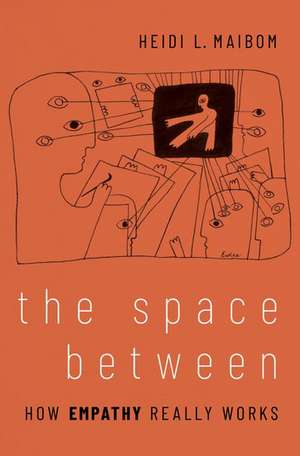The Space Between: How Empathy Really Works
Autor Heidi L. Maibomen Limba Engleză Hardback – 23 sep 2022
Preț: 188.04 lei
Preț vechi: 204.84 lei
-8% Nou
Puncte Express: 282
Preț estimativ în valută:
35.99€ • 37.43$ • 29.71£
35.99€ • 37.43$ • 29.71£
Carte disponibilă
Livrare economică 14-20 martie
Preluare comenzi: 021 569.72.76
Specificații
ISBN-13: 9780197637081
ISBN-10: 0197637086
Pagini: 320
Dimensiuni: 147 x 216 x 26 mm
Greutate: 0.49 kg
Editura: Oxford University Press
Colecția OUP USA
Locul publicării:New York, United States
ISBN-10: 0197637086
Pagini: 320
Dimensiuni: 147 x 216 x 26 mm
Greutate: 0.49 kg
Editura: Oxford University Press
Colecția OUP USA
Locul publicării:New York, United States
Recenzii
The book's audience is interdisciplinary, and the writing is accessible. The text includes useful, sometimes humorous, examples and less jargon than one would expect when philosopher meets social psychologist and lawyer. This argument for empathy in moral decision-making will be welcome in law, philosophy, and social psychology collections.
[The Space Between] is compelling in its arguments, and lively in its writing, with trenchant examples drawn not only from philosophical and psychological theorizing, but also from cultural sources as varied as A Midsummer Night's Dream, Moby Dick, and Buffy the Vampire Slayer. I learned a lot from reading this book; despite having studied empathy in one form or another for over 40 years, this book made me think about perspective taking in some entirely new ways.
Heidi Maibom's new book is a comprehensive, philosophically astute, and psychologically meticulously researched study about the role that imaginative perspective-taking plays for interpersonal understanding and our self-conceptions. The Space Between: How Empathy Really Works is a thoroughly enjoyable read in that it illustrates abstract points through well-chosen examples from literature, film, and ordinary life. It very much practices what it preaches.
The 'social brain' involves as much plastic cortex as brain areas for science, logic, and the three r's. Yet, until now, empathy has remained poorly understood. This engaging, humorous, and insightful book provides the first intellectually satisfying account of this sophisticated mode of human understanding. Maibom brilliantly reveals why empathy depends on emotion and how it makes us more--not less--impartial and objective.
The Space Between opens upmany fruitful avenues for discussion regarding perspective taking's nature, benefits, and shortcomings--discussion that we, across disciplines, have very pressing reasons to pursue.
[The Space Between] is compelling in its arguments, and lively in its writing, with trenchant examples drawn not only from philosophical and psychological theorizing, but also from cultural sources as varied as A Midsummer Night's Dream, Moby Dick, and Buffy the Vampire Slayer. I learned a lot from reading this book; despite having studied empathy in one form or another for over 40 years, this book made me think about perspective taking in some entirely new ways.
Heidi Maibom's new book is a comprehensive, philosophically astute, and psychologically meticulously researched study about the role that imaginative perspective-taking plays for interpersonal understanding and our self-conceptions. The Space Between: How Empathy Really Works is a thoroughly enjoyable read in that it illustrates abstract points through well-chosen examples from literature, film, and ordinary life. It very much practices what it preaches.
The 'social brain' involves as much plastic cortex as brain areas for science, logic, and the three r's. Yet, until now, empathy has remained poorly understood. This engaging, humorous, and insightful book provides the first intellectually satisfying account of this sophisticated mode of human understanding. Maibom brilliantly reveals why empathy depends on emotion and how it makes us more--not less--impartial and objective.
The Space Between opens upmany fruitful avenues for discussion regarding perspective taking's nature, benefits, and shortcomings--discussion that we, across disciplines, have very pressing reasons to pursue.
Notă biografică
Heidi L. Maibom received her Cand Phil from University of Copenhagen in 1994 and her PhD from University of London in 2000. She was a Postdoc in the Philosophy-Neuroscience-Psychology program at Washington University in St. Louis 2001-2003, and Assistant/Associate Professor of Philosophy at the Institute of Cognitive Science and Department of Philosophy at Carleton University 2003-2013. She has been Professor in the Department of Philosophy at the University of Cincinnati since 2014. In 2021, she became Ikerbasque Research Professor & Distinguished Professor at ILCLI at the University of the Basque Country. She has held fellowships at Cambridge University and Princeton University.
